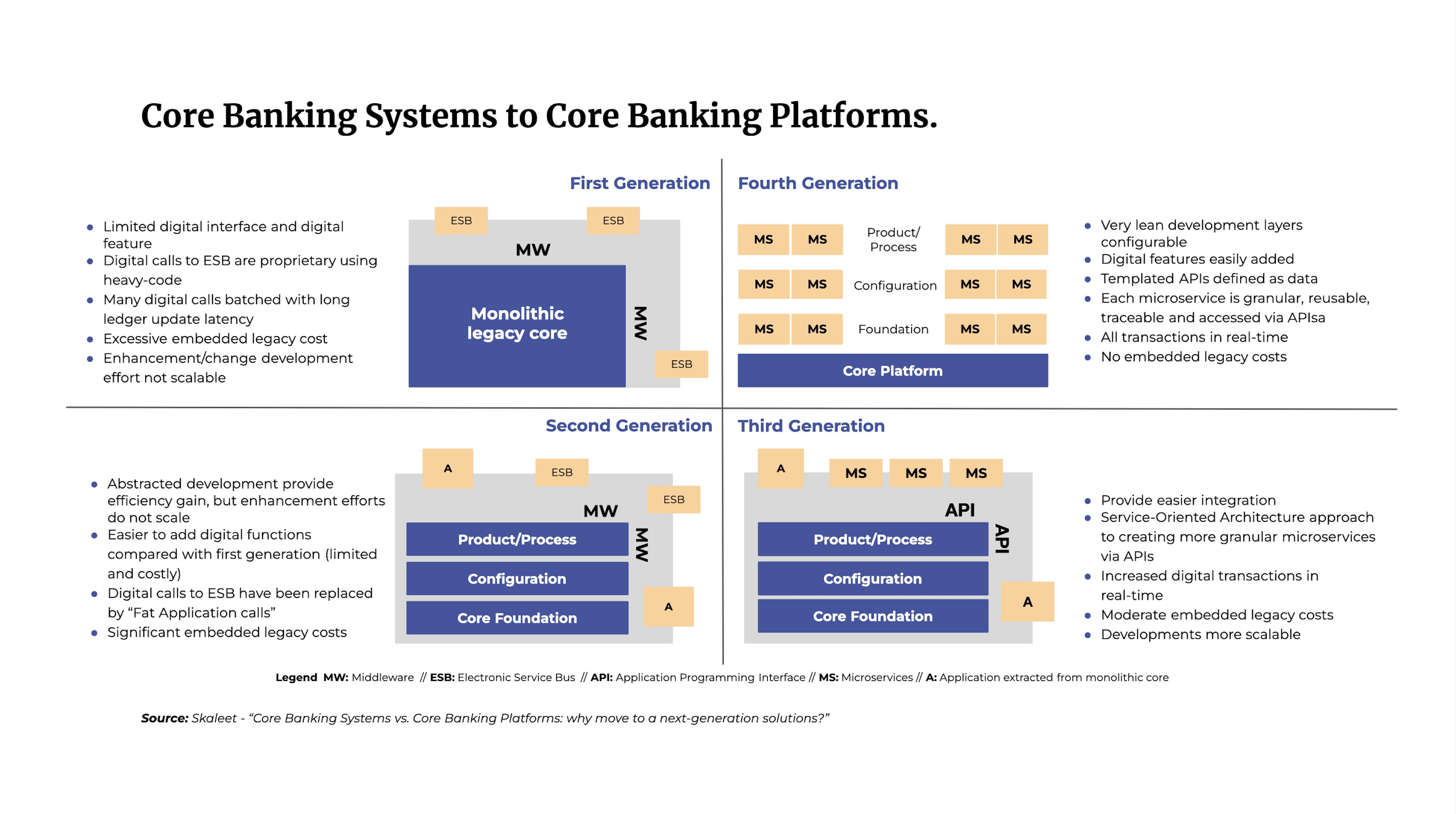
November 9th, 2022 • Core Banking
Unlocking Opportunities in Consumer Lending! 🚀
Lenders can build personalized workflows for innovative consumer credit solutions.
November 22nd, 2022 • Core Banking

While so-called traditional banks have realized that they need to evolve faster, many have already accelerated the pace of innovation with new talent, technologies, and working methods. However, they are generally hampered by IT systems from the 80s and 90s. This monolithic technology was built to handle the entirety of a financial institution’s needs. While mostly stable, it is inflexible and slow to change. In planning their IT investments, many financial institutions de-prioritized modernizing their Core Banking Systems in favor of front-end technology, such as websites, mobile apps, and the omnichannel customer experience. Many have removed applications and services, hoping to extend the life of their Core Banking System. Very few have actually moved to a more flexible back end. They must now reassess whether to prioritize making the move.
The next logical step for many banks is to implement a Core Banking Platform so they can operate with speed and agility, qualities required in an ever-changing and complex world. The Core Banking System is the heart of a bank. It is extremely difficult and expensive to migrate it. In addition, true next-generation systems are still maturing, so committing to change now can be costly and slow. To address these challenges, financial institutions must take several steps simultaneously. They must hollow out their existing Core Banking Systems while selecting several Core Banking Platforms to test on slices of their product portfolio in a “test & learn” process before deciding on a specific Core Banking Platform and fully migrating. This is a delicate and difficult exercise, often with intangible returns on investment, but it is probably the best option. Most financial institutions will need to look at their IT systems strategically and technically to decide which way to go.
The banking industry is undergoing technological changes that offer great potential for improvement, from profitability to the customer experience:
1 - Core Banking Systems closed to ecosystems
The banking industry is moving away from closed systems to an ecosystem model of operation. In the ecosystem approach, players in the financial market make their products and services available to other providers and offer third-party products via their own channels. This open architecture approach allows banks to provide components for Core Banking and other IT systems while integrating third-party components.
2 - From downstream to upstream
These days, financial institutions want to offer more dynamic and, above all, more personalized customer experiences. For example, some institutions offer loan products during the product search, while others have decided to do so after the transaction is completed.
3 - From batch processing to real-time processing
Data availability and decision-making now happen in real-time or on demand. There is no more waiting for information to be batched and processed at the end of the day. Real-time data ingestion and automatic updating of modular components significantly improve the customer experience.
4 - From reporting to advanced analytics
Financial institutions are beginning to better exploit their most valuable asset, proprietary data. New regulatory requirements, product selection, product portfolio analysis, and service providers are becoming increasingly intelligent and personalized. For example, personalized data-driven customer engagement services provided by a fintech company are now integrated into a bank’s mobile app. This allows a financial institution to give customers suggestions based on their transactions.
5 - From perimeter security to a "zero trust" security model
Most banks still rely on perimeter security to protect entry and exit points with firewalls, proxy servers, and other intrusion prevention tools. Financial institutions have moved to a “never trust, always verify” model. This model requires encryption of data in transit and at rest, multi-factor authentication, access monitoring, and features such as tokenized data. These are difficult to implement in a traditional IT architecture situation because strong security expertise is required to achieve a holistic solution.
6 - From One-size-fits-all to personalized offers
Until recently, banks expected customers to choose from a few core retail and commercial products. Today, bank customers place more and more emphasis on customization (e.g., configuring a loan product or customizing financial reports for institutional customers) or new products, such as gas cards or foreign exchange services for international money transfers.
Central to the core banking platform is its modularity, meaning that transaction management is separate from banking services such as new accounts, loan management, deposit and withdrawal processing, and other related management activities. Because of the modular architecture, localized changes are fast and easy to test and launch. In addition, associated services can be added via APIs, which aggregate their logic and data into a single point that can be connected to any other endpoint. The result is greater configurability.
1 - The Architecture
For the most part, traditional Core Banking Systems have a monolithic architecture based on legacy components developed in COBOL. These systems are very cumbersome and costly to upgrade or change. Core Banking Platforms use a containerized microservices architecture and are built using mainly open-source languages, modern coding standards, integration, and continuous deployment (CI/CD). These new architectures allow financial institutions to quickly create new products with a high level of scalability and configurability.
2 - The Infrastructure
Most traditional Core Banking Systems have a robust, on-premise infrastructure (a mainframe) which is expensive to maintain and very difficult to change over the long run. Core Banking Platforms allow you to have fully cloud-native functionality and automatic updates, whether horizontal or vertical.
3 - Data and Information Processing
In traditional Core Banking Systems, data is stored in silos. This makes it more difficult to use fully integrated business logic to create interrelationships between customers and products. As a result, there are multiple copies of the same data, whether in the legacy Core Banking System and connected to a data warehouse or within a data silo supporting a specific business function, such as fraud management. For Core Banking Platforms, the data sources are seamlessly integrated into each repository. The definition of object layers allows, for example, added individual properties to be associated with a basic account. Core Banking Platforms leverage modern IT solutions such as Graph technology to design databases dedicated to fraud detection.
4 - Processing
Traditional Core Banking Systems use batch processing, which significantly detracts from the digital experience during scheduled processing periods and maintenance hours, such as weekends and holidays. On the other hand, Core Banking Platforms carry out processing and transactions in real-time.
5 - Integrations
Integrating components into a traditional Core Banking System is complicated. Product offerings are mature and generic but difficult to customize to align with new use cases. Core Banking Platforms enable a modular EDA (event-driven architecture) deployment with an extended API layer and predefined connectivity, for example, for Know Your Customer (KYC) and account verification.
6 - Configurability
To launch a brand new feature in a traditional Core Banking System, all code changes and new releases must be approved. With a Core Banking Platform, integrations and deployments are seamless (CI/CD) with a low-code configuration to reduce development and maintenance costs. Product owners (authorized users) can easily modify the system configuration or make changes to their products.
7 - The Client Base
In traditional Core Banking Systems, customer databases are mainly used to meet the complex needs of financial institutions. Core Banking Platforms bring greater simplicity by addressing the needs of fintech companies and greenfield neobanks. Megabanks or regional banks see these solutions as a way to gradually modernize their IT infrastructure.
8 - The Revenue Model
Traditional Core Banking Systems incur a one-time deployment expense and variable expenses over time. There is also an additional expense for system maintenance, changes, and upgrades. With Core Banking Platforms, financial institutions pay for what they use under a pay-as-you-go model, including subscription fees with reduced deployment costs and pricing modeled by leveraging cloud economies of scale.
Those seeking to convey the benefits of Core Banking Platforms should refer to fintech companies and their modern architecture. We estimate that the operating costs of neobanks/fintech companies powered by Core Banking Platforms are only about 10% of such costs for traditional banks. Revenues are also depressed for the latter due to limited and simpler product suites. But these types of operating costs have shown signs of changing significantly with transaction volume and product complexity. However, the comparisons end there. In addition to being less complicated, fintech companies have a different history. They were built with these Core Banking Platforms, while traditional financial institutions have to migrate from their existing legacy code base, which raises a whole different set of issues.

Level 1: Core Banking Platforms provide compliance assurance from the start and enable data mining and customer insight, real-time fraud analysis, and personalization via plug-ins.
Level 2: Core Banking Platforms operate as a subscription service offering flexible pricing options for basic service. This helps financial institutions migrate customer accounts to a core banking platform more quickly.
Level 3: Core Banking Platforms provide built-in event streaming (EDA) to feed big data into machine learning algorithms to create personalized services. They also offer a significant number of basic APIs that can be incorporated into products and customer experiences. These platform solutions also provide out-of-the-box utilities, such as a redeployable migration engine.
Level 4: Core Banking Platforms provide higher-level development tools and capabilities that allow financial institutions to compile multiple product changes at once into code that can be deployed in minutes. These platform solutions leverage an integrated partner ecosystem to accelerate time to market and increase return on investment.
Level 5: Core Banking Platforms provide comprehensive documentation so that a financial institution’s engineers can get up to speed in a few days. They also enable organizations to deconstruct traditional Core Banking Systems into business segments and sectors to solve the problems they encounter on a daily basis.
Once these different levels have been established, financial institutions have two options for facilitating the integration of these platform solutions:
The orchestrator approach is a real-time data hub with a routing layer designed to hollow out the traditional Core Banking System freeing up space to develop new modern digital capabilities. This enables a financial institution to accelerate and reduce the risk of moving to a Core Banking Platform.
The real-time data hub and routing layer are based on an event-driven architecture (EDA) that facilitates intelligent routing of data transactions and choreographed management of APIs. At the same time, it allows the financial institution to preserve the Core Banking and card payment systems’ registration data, while maintaining data integrity and ensuring that digital experiences and applications are properly developed in all areas, such as retail banking, payment cards, loans, and so on.
The orchestration layer provides real-time data replication to choreograph data flows to the data registration system. As financial institutions gradually migrate data to the Core Banking Platform, the orchestration layer intelligently routes transactions to the specific core that holds the registration system for that data. However, you must ensure that each flow is properly mapped and integrated with the flow sets in the Core Banking Platform. In addition, the orchestrator approach provides domain APIs that can be leveraged to create experience APIs (e.g., customer onboarding), and intelligent APIs (e.g., for anti-fraud). Multiple systems can consume these APIs at the same time and across different channels (e.g., end user, back office) to provide a multitude of customer experiences.
Financial institutions today need a Core Banking Platform. However, the path to creating such a new platform is long, costly, and uncertain. To meet this strategic challenge and make this transition, Skaleet is working with financial institutions to test a Core Banking Platform by launching an ancillary project/product to test the platform solution while acquiring new customers and gradually migrating the other customers’ data over time. Financial institutions can connect other systems and solutions to the new Core Banking Platform. This approach is often used to launch a new business or to enter a new market segment.
Innovation. FinTech. Digital Banking. Neobanks. Open Banking. Core Banking. Cloud.

November 9th, 2022 • Core Banking
Lenders can build personalized workflows for innovative consumer credit solutions.